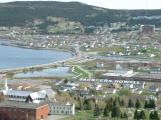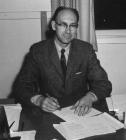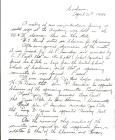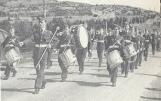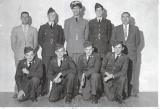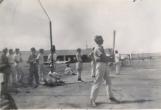1
The story of the Carbonear 589 Royal Canadian Air Cadet Squadron really began in 1952, when a young man, Hudson Davis, began teaching at the United Church College in the town. Carbonear then had a population of approximately 3,500 people with four major religions serving their spiritual neds. It was a bustling fishing and commercial town with a large population of youth. For the most part, there were no sports groups or organizations focused mainly on the young people of the town. Most children made their own fun or got involved in limited church sponsored activities. Sports such as soccer, baseball, swimming and hockey, were organized by small groups of boys or girls on the various ponds and fields in the area.In the Spring of 1954, Hudson acted on an idea that had slowly evolved from his philosophy of teaching and from his involvement with the students of his school. He decided they needed involvement in organized extra-curricular activities. A school house system was begun for both boys and girls. Activities and games took place after school under the supervision of a teacher and points awarded to each house.
However, the young boys needed more that school could offer. To fill this gap Hudson, along with friends Lloyd Powell and Roy Noel, decided to form a cadet corps. Posters were placed in prominent places around town. The key sentence on each poster read: "All men interested in the welfare of the boys of Carbonear are invited to a meeting in the Town Hall at 8:00 P.M. (on a date specified on the poster)". Eight men showed up and all were members of the United Church. It ws then decided that a second meeting would be held at the United Church College on April 20th, 1954.
3
Carbonear is one of the oldest towns in Canada. It was first mentioned by English fishing admirals in 1550. The first recorded settlement in the town was by Nicholas Guy in 1630. In a 1675 census Carbonear was listed as having 11 adults, 16 children, 8 boats, and 30 fishing servants. In 1697, the town , consisting of 22 houses, was burned by the French. In 1826 the Newfoundland School Society was established in Carbonear and had 100 students. In 1833, fifty-six sailing vessels from Carbonear were involved in the foreign salt fish trade. Carbonear was incorporated on July 13, 1948. Over the years the population steadily grew and stands at approximately 5,000 today.5
Hudson Davis came to Carbonear in 1952 and stayed until 1969. He was vice-principal of the United Church Academy until 1957 and then was appointed principal. He was elected President of the Newfoundland and Labrador Teachers' Association in 1962 and re-elected in 1963. He also served as the District Superintendent for the Terra Nova Integrated School District from 1969 to 1979. He finished his involvement in education with the Federation of School Boards and served as executive assistant and executive director from 1980 to 1985.Audio Transcript:
In 1952, I came to Carbonear to teach in the then-called United Church College. Very soon thereafter, I renewed friendships with persons from my boyhood days, one of whom was Lloyd Powell. I had first met him when he was Scout Master of the First Carbonear Troop and I was a Tenderfoot Scout in the newly formed Freshwater Troop. One day in late 1953, we were recalling with nostalgia some days at a summer scout camp in Mackinsons. We talked about reviving the Scout Troop, which had been inactive during World War II. For some reasons now forgotten, we didn't pursue the idea, but some months later, we included Roy Noel in discussions about formation of a cadet group for boys in the town. We decided to issue a call for a public meeting to discuss the issue. At the school, I printed some notices in large type and had them displayed in shop windows around town. The notices were directed at "all men interested in the welfare of the boys of Carbonear" to attend a meeting in the Town Hall on April 14, 1954, to discuss the possibility of setting up a Cadet Corps in town. Much later, with the benefit of hindsight, I know we should also have had an announcement made in all the schools because the only men who did attend that meeting other than Lloyd, Roy, and I were fathers of boys in my school, the college. This was a great disappointment for us, but those present decided not to give up, rather we would explore the possibility of a cadet group for college boys only; so, in May, our group with others invited met in the college. A formal committee was established with William Saunders as chair and George Janes, Secretary. In the days immediately following that meeting, inquiries were made of cadet authorities in St. John's re: the procedures for seeking permission to establish a cadet group for boys in Carbonear. In those days, it seemed that most leaders of Cadet Corps had served in the Armed Forces; and since Lloyd, Roy, and I fit in that category, it was expected that we be leaders of any corps that might be approved; and since Lloyd and Roy had served overseas in the 166 Newfoundland Field Regiment Royal Artillery, we first explored the possibility of forming and Army Cadet Corps here. However, when we contacted the authorities, we were told that it was policy to avoid duplication of cadet groups in neighbouring communities. An Army Corps had already been established in Bay Roberts, a Navy Corps in Harbour Grace; so, the committee's inquiry was referred to the Provincial Committee of the Air Cadet League of Canada. In short order, we were given permission to form an Air Cadet Squadron with the number 589.
7
A copy of the minutes of the first meeting held at the United Church College in Carbonear, April 20, 1954.Audio Transcript:
My name is Fred Saunders. I was one of the first 40 cadets enrolled in 589 Carbonear Squadron. I would like to note here the contributions of the members of the original Sponsoring Committee. I'm especially proud of the drive and commitment of my father, Bill Saunders, who was the original Sponsoring Committee chairman. He worked tirelessly on behalf of the Air Cadets and played an important role in the very successful early years of the squadron.
9
Hudson Davis was recommended as Commanding Officer and Lloyd Powell was recommended as Adjutant. Johnny Clarke was added as supply officer over the summer and Roy Noel was added as training Officer when the first recruits joined in the fall of 1954.11
The 514 Kinsmen Air Cadet Squadron from St. John's, paraded through Carbonear on June 5, 1954. It was a great public relations exercise to usher in the birth of the new 589 Carbonear Squadron. The St. John's cadets were invited into the homes of the Carbonear cadets to be.Audio Transcript:
Hudson Davis recalls... Squadron 514 in St. John's, with Gerry Bastow as CO, agreed to help us in the formative days. They provided a great boost for us when, on June the 5th, the squadron visited Carbonear, paraded through the streets with their band, and were hosted in our homes.
13
The first 6 boys from Carbonear to attend summer camp at Canadian Air Force Base, Greenwood, Nova Scotia were Fred Saunders, Keith Taylor, Art Oats, Ernest Cole, James Pike, and Ernest Pike. They went as guests of Kinsmen 514 Squadron of St. John's. Accompaning them were Commanding Officer Hudson Davis, and sponsoring committee members William Saunders and George Janes. These 6 boys were not yet truly cadets as the squadron had not yet had its initial enrollment. However, they were invited by 514 squadron in order to generate some interest in the town for the cadet movement.Audio Transcript:
My name is Fred Saunders. I can still remember the elation I felt when I was chosen as one of the six cadets to attend summer camp at Greenwood, Nova Scotia as a guest of 514 Kinsmen Squadron of St. John's. Not only was this an opportunity to experience my first plane ride, but to attend a two week summer camp on the mainland was a big deal to any young teenager growing up in Carbonear in 1953, or indeed growing up in any other town in Newfoundland.
